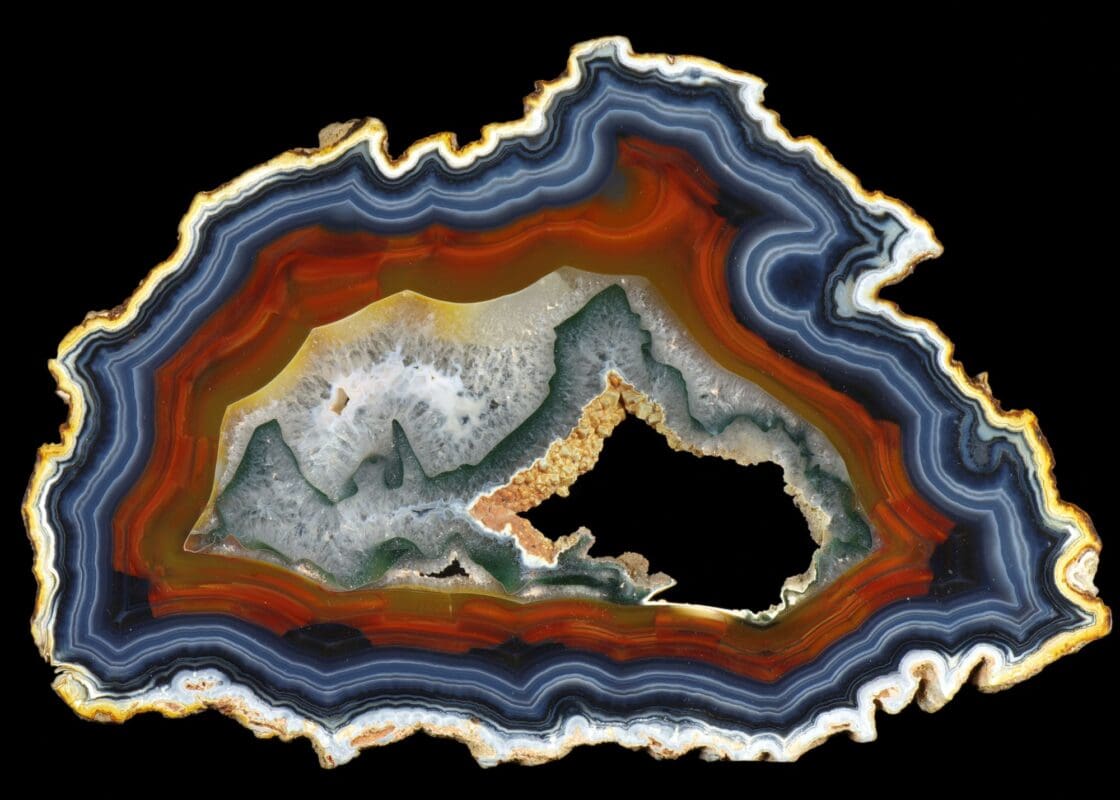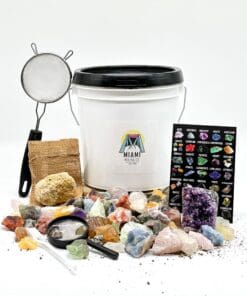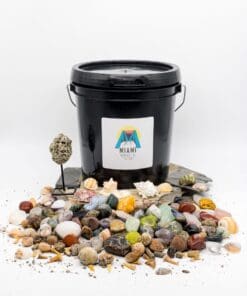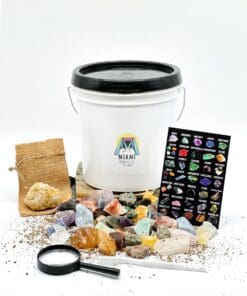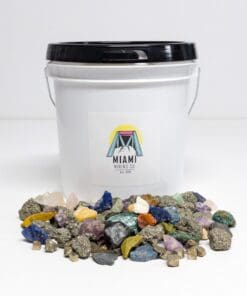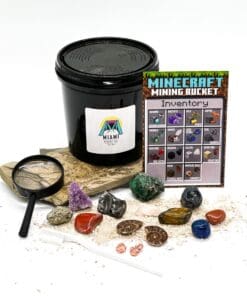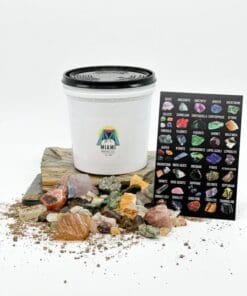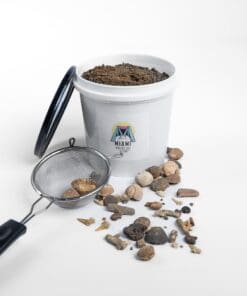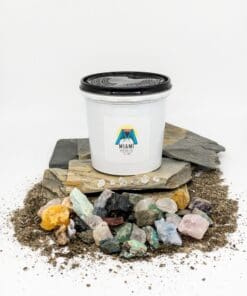Gem Mining Kentucky: A Treasure Hunter’s Guide to the Bluegrass Jewels
The Bluegrass State, more commonly recognized for its horses and bourbon, also conceals a rich treasure below its soil – gemstones. Mining for these hidden gems has long attracted enthusiasts, locals, and tourists alike, with a promise of discovering the treasures the land has to offer. This article takes you on a journey through Kentucky’s gem-laden soil, revealing the state’s most precious stones and where to find them.
The Most Popular Gemstones in Kentucky
Kentucky’s rich geology makes it home to both rare and common gemstones. These stones vary from exquisite rarities sought after by collectors to more commonly found gems that still catch the eye of many. Here’s a closer look at some of the treasures you might find under the Bluegrass State’s soil:
Rare Gemstones Found in Kentucky:
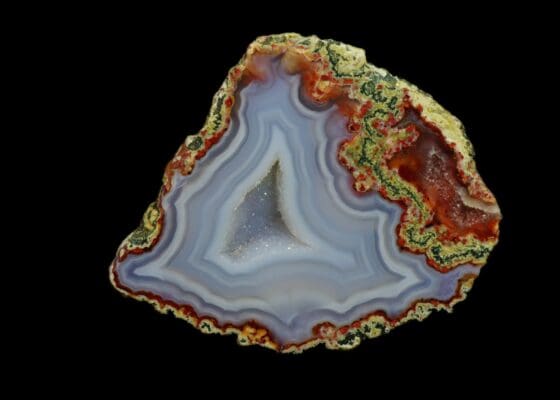
| Gemstone | Description |
|---|---|
| Kentucky Agate | Often characterized by its exquisite bands of color, this agate variant is among the most beautiful globally. Its patterns are unique, with shades of red, black, and white predominating. |
| Fluorite | Typically found in the Western parts of the state, this mineral can appear in a range of colors. Notably, the blue fluorite – like the famed Miller Fluorite – is highly prized. |
| Sphalerite | This zinc ore crystal often boasts an impressive resinous luster. In its gem-quality form, it can be transparent with fiery orange and yellow hues. |
| Barite | Commonly found alongside fluorite in Western Kentucky, its tabular crystals can form beautiful rose-like aggregates. |
| Pyrite | Known as “Fool’s Gold,” this mineral can form perfect cubes, showing a metallic gold-like luster. It’s often found alongside other minerals like quartz. |
Common Gemstones Found in Kentucky:
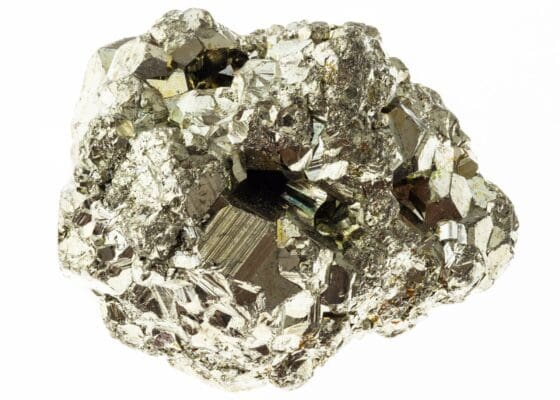
| Gemstone | Description |
|---|---|
| Quartz | Ubiquitous and versatile, quartz crystals can be found all over Kentucky. Varieties include smoky, clear, and rose quartz. |
| Calcite | This mineral is often found in limestone caves in Kentucky. Its crystals can be transparent to opaque with a waxy luster. |
| Dolomite | A close relative of calcite, dolomite forms pink, white, or yellow rhombohedral crystals. |
| Galena | This lead ore is heavy and can be found in cube-shaped crystals with a metallic luster. |
| Chalcopyrite | This mineral, similar in appearance to pyrite, often shows a more brassy yellow and can tarnish to iridescent hues. |
| Limestone | As the state rock of Kentucky, limestone is prevalent and often contains fossilized remains from ancient seas. |
| Shale | Predominant in Eastern Kentucky, shale is sedimentary rock that can contain beautifully preserved fossils. |
| Gypsum | Often found in layered sedimentary deposits, its crystals can be clear, white, or even have a slight reddish hue. |
| Celestite | Found in small quantities, these sky-blue crystals can be a delightful discovery for gem hunters. |
| Hematite | This iron oxide mineral is often red to reddish-brown and is known for its earthy luster. |
Whether you’re hunting for the rarer gems that offer a touch of the unique or seeking the more widespread gems that tell Kentucky’s geologic story, there’s something for everyone in this diverse state.
Top Gem Mining Locations in Kentucky

- Ben E. Clement Mineral Museum: Situated in Marion, this museum not only educates visitors on Kentucky’s rich mineral history but also offers hands-on public mining experiences. Renowned for its fluorite, you can mine for this and other gems. Operating hours vary by season, so it’s best to check their website. A fee is charged for mining, which often includes a guided tour.
- Kentucky Agate Hunters: The eastern regions of the state, especially around Irvine, are hotspots for agate hunting. While there aren’t official mines here, there are numerous spots recognized by locals. Always remember to seek permission before mining on private lands.
- Wickliffe Mounds State Historic Site: Located near the town of Wickliffe, this historic site is more about the history than the gems, but you might find chert, a type of quartz, and other minerals here. Operating hours are typically from 9 am to 5 pm daily with a small entrance fee.
- Allen Co. Fluorite Mines: Nestled near the Western Kentucky border, this site boasts rich veins of fluorite among other minerals. Mining here requires permission as many mines are on private property.
- Mason’s Garnet Mine: Near the town of Eddyville, Mason’s Garnet Mine offers gem enthusiasts a chance to mine garnets, which are slightly rarer in Kentucky. As with many mining sites, it’s essential to call ahead for hours and fees.
- Cave City’s Fossil Locations: While not gemstones per se, the fossil sites around Cave City are popular for those looking to unearth ancient remnants. Operating hours are generally daylight hours, but as the sites can be scattered, always research before heading out.
- Green River Stone Hunting: The Green River, especially around the Mammoth Cave National Park, offers an opportunity to sift through stones and find unique gems and minerals. No specific operating hours, but be aware of park guidelines and any required permits.
- Red River Gorge Geological Area: In the heart of the Daniel Boone National Forest, this area allows gem hunters to find quartz and other minerals amidst the backdrop of stunning natural beauty. It’s open year-round, but individual camping and activity fees may apply.
- Harrodsburg Road Gold Site: Near Nicholasville, this location is historically famous for minor gold finds. While you’re more likely to find quartz or chert, the possibility of spotting a gold flake keeps it popular. No set operating hours, but always be respectful of the land.
- Pikeville’s Crystal Mines: In the eastern part of the state, Pikeville offers sites known for quartz crystals. Check with local gem and mineral clubs for details on best spots, operating hours, and any associated fees.
When planning your gem hunting journey in Kentucky, always consider reaching out to local gem and mineral societies. They can offer insights, updates on site accessibility, and valuable tips to ensure a successful and enjoyable mining experience.
History of Gem Mining in Kentucky

Kentucky’s gem mining history is as varied and colorful as the very gems and minerals nestled beneath its terrain. The region’s geology, a tapestry woven through eons of tectonic shifts, erosions, and sediment deposits, has created a land ripe with mineral wealth. From early Native American tribes to modern gem enthusiasts, the land’s rich geological tapestry has captivated countless generations.
Native American tribes were the state’s first miners. They diligently sought chert, a type of flint, from the lands that would later become Kentucky. Valuing it for its sharpness and durability, they expertly crafted tools, weapons, and ornate jewelry. These tribes, with their innate knowledge of the land, became pioneers in understanding and utilizing the region’s natural resources.
As European settlers began to populate the region in the 18th and 19th centuries, stories of gem-rich lands started to circulate. Tales of breathtaking agates, shimmering quartz, and captivating fluorite veins drew many to Kentucky’s mineral-rich areas. As a result, small mining operations sprouted, with families and communities often working together to extract the earth’s treasures.
The 20th century heralded significant changes. The Illinois-Kentucky Fluorspar District, particularly in the western parts of Kentucky, boomed. Fluorite became a sought-after mineral for its industrial applications, propelling the region into a large-scale mining endeavor. Towns such as Marion grew in prominence, evolving into hubs for mineral extraction and trade.
Furthermore, while large-scale mining operations focused on minerals like fluorite, many individual prospectors and hobbyists continued to unearth a variety of gemstones across the state. Their discoveries, often fueled by passion rather than profit, contributed immensely to the state’s reputation as a gem-hunter’s haven.
However, as with many mining narratives, there were challenges. Environmental concerns and diminishing returns led to the decline of some mining operations. Yet, Kentucky’s gem mining history wasn’t merely about extraction but also about the human spirit’s tenacity, wonder, and connection to the earth.
Today, remnants of this rich history are still evident. From museums to active mining sites, Kentucky’s past melds seamlessly with the present, inviting all to partake in its vibrant gem mining legacy.
Gem Mining Regulations in Kentucky

Understanding the gem mining regulations in Kentucky is pivotal for both seasoned miners and hobbyists. These rules, framed by a blend of respect for the land and the rights of property owners, ensure that the tradition of gem hunting can continue without adverse effects on the environment or private properties.
1. Land Ownership and Permission: The foremost consideration for prospective miners is determining land ownership. A significant portion of mining locales falls on private property. Unlike some states, Kentucky does not have a free-access policy to minerals on private lands. This means you need explicit permission from the landowner before prospecting or mining. Skipping this step can lead to trespassing charges. In cases where the land is leased or rented, both the tenant’s and the landowner’s permission might be required.
2. Designated Public Areas: While many gem-rich areas are on private property, there are designated public lands where enthusiasts can search for minerals. Such areas often have specific guidelines about where one can mine and how much material one can remove. Always adhere to posted rules or obtain information from local ranger stations or visitor centers.
3. Environmental Considerations: The Kentucky Department of Natural Resources and Environmental Protection has guidelines aimed at preserving the state’s natural beauty. This includes restrictions against harmful mining practices that could lead to soil erosion, water contamination, or habitat disruption. Any mining activity, even on a small scale, should prioritize minimizing environmental impact.
4. Commercial vs. Personal Mining: There’s a distinction between mining for personal use and commercial mining. If you’re planning to sell the gems you find, you might require additional permits and need to report the income for tax purposes. Moreover, commercial operations might fall under more stringent regulations and oversight.
5. Fossil Collecting: While not gem mining per se, collecting fossils, prevalent in areas like Cave City, has its regulations. In general, fossils can be collected for personal use from most public lands managed by the Bureau of Land Management (BLM) without a permit, as long as it’s not intended for commercial purposes.
6. Safety Regulations: Safety is paramount, and there might be specific guidelines depending on the area. This can include wearing helmets in cave areas, using proper equipment, and adhering to posted warnings.
It’s always advisable to keep yourself updated. Before setting out, contact the Kentucky Department of Mines and Minerals or local gem and mineral clubs. They can offer up-to-date information on regulations, permit requirements, and other essential details.
In essence, while the allure of unearthing Kentucky’s hidden gems is exciting, it’s equally crucial to embark on this journey with knowledge and respect for the state’s regulations. This ensures that the tradition remains sustainable and enjoyable for future generations.
Necessary Tools and Equipment for Gem Mining in Kentucky
Gem mining in Kentucky, like any geological venture, requires a blend of enthusiasm, knowledge, and the right tools. Whether you’re sifting riverbeds, exploring rocky outcrops, or delving into deep mines, having the appropriate equipment ensures not only a productive search but also the safety of the prospector.
1. Screening and Classifying Tools: Reveal those hidden treasures!
Description: Especially useful for riverbed searching, these screens help separate larger rocks and debris from potential gemstones. They come in various mesh sizes, and it’s advisable to have a set to sift through different layers of sediment.

🛒 Explore Top Screening Sets on Amazon
2. Shovels and Trowels: Digging deep or just scratching the surface?
Description: For digging into softer soils or clearing away surface debris, a sturdy hand shovel or trowel is indispensable. It aids in unearthing potential gem-containing substrates.

🛒 Find Quality Shovels and Trowels on Amazon
3. Picks and Hammers: The backbone of any gem hunting endeavor.
Description: This is a miner’s best friend. With one end pointed and the other flat, it’s designed to break and split rocks, making it easier to extract gems and minerals.

🛒 Check Out Best Picks and Hammers on Amazon
4. Buckets: Your trusted companion for carrying treasures.
Description: As you uncover gems, you’ll need a safe place to store them. Durable buckets or cloth bags are ideal, ensuring your finds remain undamaged during your expedition.

🛒 Shop for Reliable Buckets on Amazon
5. Magnifying Glass: Every detail counts!
Description: A closer inspection of potential finds can often reveal details not immediately visible to the naked eye. These tools are perfect for the job.

🛒 Grab Your Magnifying Glass on Amazon
6. Guidebooks and Field Guides: Knowledge at your fingertips.
Description: A comprehensive field guide can be instrumental. Not only does it help in identifying potential finds, but it also offers insights into the types of rock formations or regions where specific gems might be found.

🛒 Discover the Best Field Guides on Amazon
7. Containers and Bags: Organize, store, and flaunt your finds.
Description: As you collect samples, you’ll need containers or pouches to store them. Clear plastic containers or zip-lock bags are ideal as they allow for easy viewing without opening.

🛒 Shop for Storage Solutions on Amazon
8. First Aid Kit: Better safe than sorry!
Description: Minor injuries like scrapes or splinters can happen. Having a basic first aid kit ensures you can address these issues promptly.

🛒 Secure Your First Aid Kit on Amazon
When embarking on a gem hunting journey in Kentucky, while these tools form the basics, individual locations might require specialized equipment. Always research ahead and ensure you’re prepared, not just to uncover Kentucky’s hidden treasures, but to do so safely and responsibly.
Tips and Tricks for Successful Gem Mining in Kentucky

Gem mining in Kentucky is as much an art as it is a science. To navigate the nuances of the terrain, uncover hidden treasures, and ensure a fulfilling experience, there are several tips and tricks that both novices and seasoned miners should keep in mind.
1. Educate Yourself: Familiarize yourself with the types of gemstones native to the regions you’ll be exploring. Knowing what to look for can save time and increase the odds of a successful find. Field guides, online forums, and local gem and mineral clubs can be invaluable resources.
2. Time it Right: The best time for gem hunting often follows a rainfall. Rain can wash away the topsoil, exposing new gem deposits. However, always ensure that conditions are safe, especially when exploring riverbeds or slippery terrains.
3. Start Early: Beginning your mining endeavors early in the day offers a twofold advantage: it provides ample daylight hours for exploration, and it can help you beat the crowds in more popular areas, allowing for a peaceful search.
4. Stay Patient: Gem mining is a game of patience. Don’t get discouraged if you don’t find something right away. The thrill lies in the hunt as much as in the discovery.
5. Network with Locals: Local gem enthusiasts and residents can offer insights that aren’t found in guides or books. Engaging with them can lead you to lesser-known spots or provide tips on the most promising areas in well-trodden locations.
6. Leave No Trace: As you explore, ensure you leave the environment as you found it. Fill in any holes you dig, pack out any trash, and respect local flora and fauna.
7. Safety First: Stay aware of your surroundings. If you’re in a wooded area, be conscious of local wildlife. In rocky terrains, watch your footing. Always inform someone of your whereabouts, and consider mining in pairs or groups for added safety.
8. Respect Boundaries: Avoid trespassing. Always secure permissions for private lands and adhere to guidelines in designated public mining areas.
9. Document Your Finds: Keeping a log of where and what you find can be immensely rewarding. Not only does it serve as a memento of your trips, but it can also help you identify patterns in where gems are located.
10. Stay Hydrated and Protected: Kentucky’s weather can be unpredictable. Carry sufficient water, wear sunscreen, and bring along insect repellent. Protective clothing, like long sleeves and hats, can shield you from the elements.
In essence, successful gem mining in Kentucky is a blend of preparation, respect for the land, and a touch of adventurist spirit. With these tips in hand, your quest for the state’s hidden jewels promises to be both exciting and rewarding.
Handling Your Gemstone Finds

Discovering a gemstone during your mining adventure can be an exhilarating moment. However, after the initial thrill comes the responsibility of handling, preserving, and showcasing your finds to maintain their beauty and value. Here are some guidelines to help you treasure these geological marvels properly:
1. Gentle Cleaning: Begin by cleaning off any loose dirt or debris using a soft brush. For more stubborn dirt, soak the gemstone in warm water with a touch of mild soap. Avoid using harsh chemicals, as they can damage some stones.
2. Proper Storage: Store individual gemstones in soft cloth pouches or padded gem jars. This ensures they don’t get scratched or chipped when in storage. For raw or uncut gems, consider storing them in a box with separate compartments.
3. Record Keeping: Along with physical storage, maintain a detailed log of each gem. Note down its type, where it was found, its weight, dimensions, and any other pertinent details. This documentation can be useful for valuation or educational purposes.
4. Identification: If unsure about the type of gemstone you’ve found, consult a gemologist or an experienced member of a local gem and mineral club. Proper identification can offer insights into the stone’s value and potential uses.
5. Display: For those gems you wish to showcase, invest in quality display cases. UV-resistant cases are excellent as they prevent colors from fading. Ensure the cases are kept away from direct sunlight and extreme temperature changes.
6. Cutting and Polishing: Some gemstones might benefit from professional cutting and polishing, enhancing their beauty and value. If considering this route, consult with a reputable lapidary or gem cutter.
7. Setting into Jewelry: Transforming your gem find into a piece of jewelry can be a gratifying way to wear and display it. Engage with skilled jewelers familiar with working on raw gemstones.
8. Insurance: If your find is of significant value, consider having it appraised and insured. While the sentimental value is irreplaceable, insurance offers peace of mind against potential loss or damage.
9. Education: Investing time in understanding gemstones’ properties can help in their maintenance. Some gems might be sensitive to light, heat, or certain chemicals, so knowledge aids in preserving their integrity.
10. Resist Quick Sales: Before rushing to sell a significant find, take time to understand its market value. Consult with experts and perhaps even get a formal appraisal.
In conclusion, your gemstone discoveries are tangible connections to the earth’s ancient past. Handling them with care, respect, and knowledge ensures they remain treasured keepsakes, reflecting your passion and dedication to unearthing nature’s buried wonders.
Famous Gemstone Finds in Kentucky
Kentucky, with its rich geological history, has been the stage for several astonishing gemstone discoveries. These finds, whether sparkling in museums or setting records in marketplaces, have carved out a significant niche in the annals of gemstone lore. Here’s a look at some of the most celebrated gemstone finds in the state:
1. The Perry Diamond: Found near the banks of the Cumberland River, this impressive diamond weighing over 2 carats caught the attention of gem enthusiasts nationwide. Its pristine clarity and unique cut have made it a gem of note in several exhibitions.
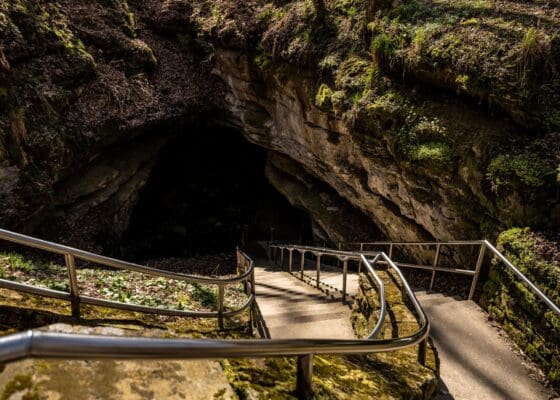
2. The Mammoth Cave Onyx: Discovered deep within the iconic Mammoth Cave, this striking specimen of onyx stands as a testament to the cave’s diverse mineral riches. Its bands of contrasting colors have made it a sought-after specimen among collectors.
3. Harlan Sapphire: Unearthed in the rugged terrains of Harlan County, this blue gemstone dazzled with its size and clarity. It remains one of the most significant sapphire discoveries in the region.
4. The Green River Agate: Located near the Green River, this agate’s swirling patterns of reds, browns, and whites have made it an emblematic find, often associated with Kentucky’s mineralogical treasures.
5. Powell’s Emerald: Discovered by a young prospector in Powell County, this emerald’s deep green hue and remarkable size were widely reported in gemstone journals, bringing further attention to Kentucky as a promising locale for precious stones.
6. The Bluegrass Pearl: While pearls are not stones, this noteworthy find in the freshwater mollusks of the Kentucky River has cemented its place in the state’s gem history due to its perfect round shape and lustrous sheen.
7. Barren’s Topaz: Extracted from Barren County, this topaz find caught the attention of many, not just because of its considerable size but also due to its flawless structure and radiant shine.
8. Cave City Quartz Cluster: This intricate cluster of clear quartz crystals, found near Cave City, remains a spectacle due to its symmetry and the sheer number of individual crystals intertwined in the formation.
9. The Red River Ruby: Though rubies are rarities in Kentucky, this particular specimen from the Red River region stood out for its deep red hue and impeccable clarity.
10. Kentucky’s Fluorite Wonders: While individual fluorite specimens from the state might not carry renowned names, Kentucky’s Western District is famed for its high-quality, multicolored fluorite, contributing significantly to the country’s fluorite production.
These celebrated finds not only shine a light on Kentucky’s mineralogical wealth but also inspire generations of gem enthusiasts to explore, hoping to add another notable discovery to this illustrious list.
Additional Gem Mining Opportunities
Kentucky’s bounteous gem-rich terrains are complemented by equally promising opportunities in neighboring states. Here’s a glimpse into the gem mining potentials of the states that border Kentucky:
1. Ohio Gem Mining: Known for its Flint Ridge flint, Ohio provides gem enthusiasts a chance to unearth this stunningly patterned stone, which Native Americans historically used for making tools.
2. West Virginia Gem Mining: With deposits of beautiful red and pink corals, West Virginia offers a unique gem-hunting experience against the backdrop of its majestic mountains.
3. Virginia Gem Mining: Famous for its exquisite specimens of amazonite, garnets, and unakite, Virginia beckons those passionate about vibrant, colored gems.
4. Tennessee Gem Mining: A haven for rubies, sapphires, and quartz crystals, Tennessee’s varied landscapes hide a plethora of gem treasures.
5. Missouri Gem Mining: Renowned for its galena and vibrant druzy quartz, Missouri’s old mines and rocky terrains promise a delightful quest for the determined gem seeker.
6. Illinois Gem Mining: Particularly famed for its fluorite deposits, Illinois offers miners a chance to discover variously hued specimens, especially in the southern regions of the state.
7. Indiana Gem Mining: Limestone-rich Indiana also hides geodes filled with quartz, calcite, and other minerals, making it a paradise for those keen on cracking open nature’s surprise packages.
Exploring these neighboring states can add diverse colors, textures, and experiences to your gem-hunting endeavors, making the region a veritable hotbed for mineralogical wonders.
For a deep dive into gem mining locations and tips, explore our Gem Mining Near Me guide.
The Timeless Lure of Kentucky’s Gems and a Novel Alternative
The allure of gem hunting in Kentucky lies in the promise of discovery—every expedition carries the potential of unearthing a fragment of the Earth’s hidden treasure. Whether it’s the gleam of a newly discovered quartz or the thrill of stumbling upon a unique gemstone, Kentucky offers a captivating tapestry of experiences, weaving together nature’s beauty, history, and adventure.
However, not everyone can embark on these outdoor quests. For those who yearn for the excitement of gem discovery from the comfort of their homes, there’s a perfect alternative: the Gem Mining Kit. This curated collection encapsulates the essence of gem hunting, offering a mix of rough gemstones waiting to be sifted, examined, and admired. It’s an engaging, educational, and entertaining venture, making the world of gemology accessible to all. Dive into the magic of mineralogy, be it in Kentucky’s vast terrains or on your living room floor.

